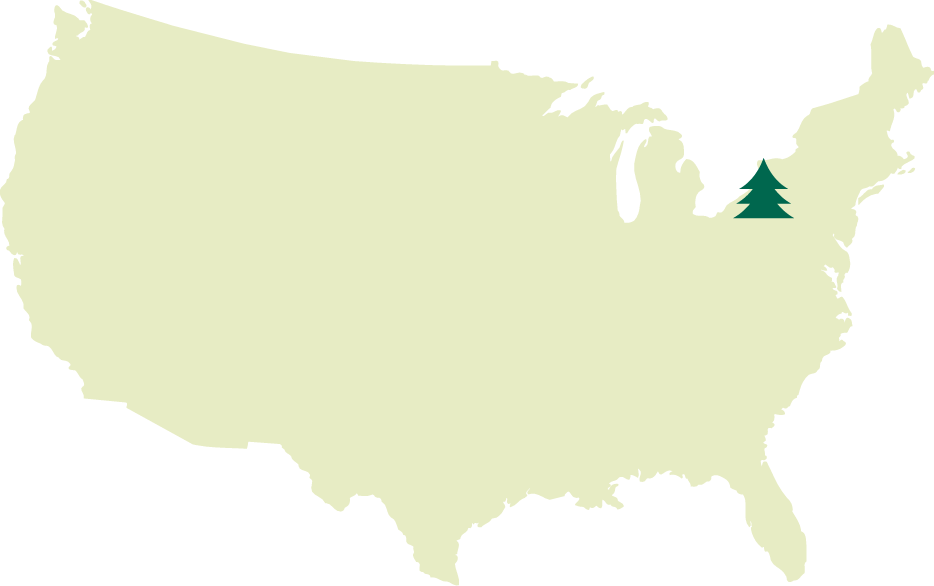The management of the CPF is guided by the following biological goals:
- Maintain the health and productivity of the forest in all aspects
- Maintain and improve the timber quality and production for maximum sustainable yield
- Maintain diverse ecological systems of the forest compatible with the production of the primary commodity – timber
- Protect water quality on the forest
- Protect and enhance biodiversity and wildlife habitat
The CPF forestry staff currently employs nine professional foresters and forestry technicians to manage the CPF. They are responsible for all land management activities on the CPF, the sale of veneer logs and pulpwood, and all timber harvesting. All harvesting and hauling of timber products, road construction and road maintenance is done by local logging and excavating contractors, under the supervision of the forestry staff. Local forestry consultants are contracted for some forestry activities such as data collection, boundary maintenance and timber marking.
All timber stands, roads, watercourses, etc. on the CPF are mapped using aerial photography, ground surveys and Global Positioning Systems (GPS). All mapping and associated data are tracked using a computerized Geographic Information System (GIS).
The Annual Allowable Harvest for the CPF is calculated using a computer based, timber management and growth model (Remsoft Spatial Planning System software or WOODSTOCK). WOODSTOCK utilizes GIS spatial data, timber inventory and growth data combined with management goals and priorities to model how various harvest strategies will affect the age structure and forest condition over time. The model can project the condition of the forest into the future under the various harvest strategies. This analysis allows for a sustainable harvest strategy to be developed which can be broken down to goals for acres to be harvested and a resulting volume of timber products. The GIS can then use annual harvest data to monitor progress toward long-term management goals.
The CPF forestry staff examined the implications of many different management scenarios and their effects through the year 2155. This forward looking analysis reflects the long range view of forest management of the Collins Companies.
Reflecting the logging history of the Allegheny Plateau, the CPF consists of primarily even-aged, second growth hardwood stands, which originated after the large-scale clear cutting around the turn of the last century. Many of the stands are reaching maturity. Some have been logged using a variety of partial harvests. Timber management in these mature stands focuses on natural regeneration and on threats to stand health. Natural regeneration is naturally occurring seedlings and saplings growing in a forest. They generally originate from seeds of the mature overstory trees in the stand. These seedlings and saplings will grow and become the next forest stand if the larger overstory trees die or are harvested.
The greatest threats to forest health on the CPF are insect infestation, disease, windthrow, over-browsing by white tail deer and a lack of natural regeneration. Insects, disease and windthrow can kill or blow down mature trees either individually, in small groups or over large areas. If the trees are not salvaged within 1-2 years, they will deteriorate and will not be usable for forest products. If natural regeneration is not present on the site prior to the loss of mature trees (seed source), the area may not grow new trees without substantial investment in planting or artificial regeneration.
High deer populations have been present in most of Pennsylvania since the 1930’s. White tail deer are preferential browsers eating primarily woody seedlings and some herbaceous plants and wildflowers. Deer generally will not eat grass, ferns and some undesirable woody species. Where deer populations are high, they can have a significant negative impact or even eliminate desirable natural regeneration from the forest.
Timber management on the CPF focuses on regenerating the mature stands, which are the most susceptible to or affected by these threats. Mature timber stands are evaluated on health, quality, past history and threat to the seed source. The most threatened stands are prioritized for harvesting. The first objective is to establish a healthy, diverse, vigorous understory of desirable seedlings and saplings (natural regeneration) which will ensure that the forest will remain productive and well stocked with trees when the overstory trees are harvested.
As previously stated, most of the CPF timber stands are even aged. Even age stands lack much of the structural diversity present in stands with multiple age classes of trees.
When stands on the CPF are to be regenerated, the overstory trees are carefully evaluated. Less common species and wildlife trees are individually marked to be protected. Vigorous, good quality, desirable trees are also be marked for retention. Important features within stands such spring seeps and vernal pools are protected.
When a healthy, diverse understory of seedlings and saplings is present and when wildlife trees, less common species and vigorous, good quality trees are protected, then other trees can be harvested. Species composition and density of the protected trees in the new stands will be variable and will depend on individual stand and site characteristics. The new stands created by this management system will be healthy, vigorous stands with good species diversity and structural diversity. The focus is on what is being left in the forest, not on what is being harvested.
Decisions on timing and location of harvest areas are based on more than just in-stand conditions. Harvesting decisions must be made in the context of the larger landscape. CPF foresters consider tract size, harvest area size, adjacent land ownership, adjacent land use, connectivity, wildlife habitat, water quality and other factors. All of these factors are weighed when making decisions on the timing and location of harvest areas on the CPF.

